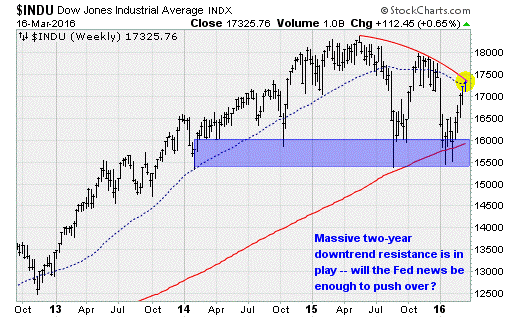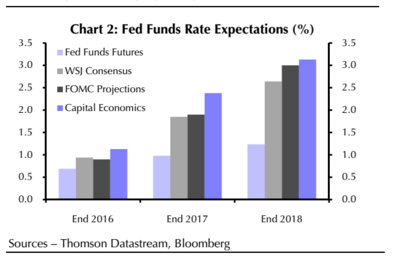The Fed and higher rates: How soon, how often?
Spooked by recent financial market turmoil and global economic uncertainties, the Federal Reserve on Wednesday decided to punt: The monetary policymakers held off on any new interest rate hikes, cut their "dot plot" forecast to two rate hikes this year (down from four) and dropped their economic forecast (2016 GDP at 2.2 percent vs. 2.4 percent before). The futures market now puts the odds of a June rate hike back below 50 percent, with better-than-even odds not seen until September.
While this raises worries that the central bank is about to fall behind the curve on inflation amid a pickup in core prices and a tightening labor market, it was what stock investors obviously wanted to hear.
In the end, the Dow Jones industrials index gained 74 points, or 0.4 percent, to nudge right against downtrend resistance from an epic, two-year-old topping pattern that started last summer (chart below).
It should be noted that a "no hike" decision from the Fed back in January gave way to fresh market weakness after the Bank of Japan cut rates into negative territory. So, a continuation of Wednesday's gains is far from guaranteed. Moreover, weakness in small-cap and financial stocks remains a concern.
And finally, should inflation continue to heat up, the Fed won't be able to simply back away from further rate hikes whenever the stock market gets bumpy. Core consumer price inflation increased at a higher-than-expected 0.3 percent monthly rate in February, pushing the annual rate to 2.3 percent for the strongest increase since May 2012.
Economic data has been coming in stronger as well, with single-family housing starts increasing to their highest level since late 2007. The missing ingredient has been robust wage gains, something Fed Chair Janet Yellen said, during her post-announcement press conference, that she expected to see.
On the surface, markets are understandably relieved that the large gap between futures market interest rate expectations and the Fed's own forecast have closed dramatically over the past year. But now the question is: Where do we go from here?
JPMorgan economist Michael Feroli is looking for two rate hikes this year, at the July and December meetings. If so, this would be slightly ahead of market expectations and a possible source of disappointment. But even this could be a best-case scenario for traders, as Feroli noted that "recent solid employment and inflation data may argue for a hike earlier than July."
The team at Capital Economics is also looking for the Fed to turn more hawkish soon with an expectation for a June rate hike followed by an acceleration in inflation that will "force the Fed to raise rates much faster than is widely appreciated."
This outlook, predicated on hard economic data, could be enough to push stocks down from current levels and result in a retest of recent lows near Dow 16,000 as the specter of even higher interest rates later this year sinks in.
How high? Steve Murphy at Capital Economics is looking for as much as 1.25 percent by year-end 2016 (chart above) and as much as 2.5 percent by year-end 2017.



